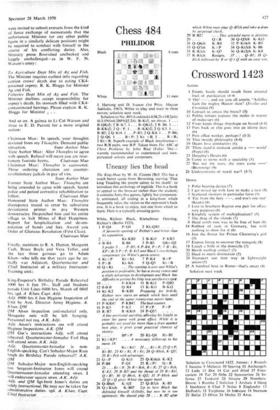Chess 484
PHILIDOR
J. Hartong and D. Ivanov (1st Prize, Magyar Sakkelet, 1967). White to play and mate in three moves; solution next week.
Solution to No. 483 (Loshinski-b3K2b/r1R2p1r/ 4k3/1N1n4/2BP1Q2/24): B-Kt3, no threat. 1 ...
B-QKt2; 2 R-K7. 1 R-QKt2; 2 R-B6. 1 ... BLKKt2; 2 Q x P. 1 . . . R-KKt2; 2 Q-K5. 1 .
B-B3; 2 Q-Kt4. 1 P-B3; 2 Q-K4. 1 . P-B4; 2 Q-Q6. 1 . . . BxP; 2 Kt xB. 1 . . R x R; 2 Kt x R. Superb example of Black interference— two R/B pairs, one B/P. Taken from The ABC of Chess Problems by John Rice (Faber 70s) warmly recommended to experienced and inex- perienced solvers and composers.
Uneasy lies the head
The King-Hunt by W. H. Cozens (Bell 32s) has a much better quote from Browning, starting 'That king Treading the purple calmy to his death', to introduce this anthology of regicide. This is a book to appeal to the browser rather than the student; it contains forty-five games, lightly but competent- ly annotated, all ending in a king-hunt which frequently takes the victim to the opponent's back row. It is a book to enjoy, not one from which to learn. Here is a typically amusing game.
White, Richter. Black, Kretschmar. Opening, Richter's (Berlin 1925).
1 P-04 P-Q4 2 Kt-QB3 . . . A favourite opening of Richter's and better than its reputation.
Kt-KB3 3 B-Kt5 P-KR3 4 B-R4 B-B4 5 P-B3 QKt-Q2 I prefer 5 . . . P-B3; 6 P-K4, Px P; 7 Bx Kt, KP x B; 8 P x P, B-103 and Black's two bishops compensate for While's pawn centre.
6 KtxP KtxKt 7 P-K4 BxP 8 PxB Kt-K6 9 Q-Q3 Kt x B
10 Q x Kt .. . The opening is over and White's position is preferable; he has a strong centre and a slight advantage in development and Black has difficufty in getting his king too satisfactory spot.
10 . . . P-KKt4 11 B-Kt3 P-QB3 12 0-0-0 Q-R4 13 K-Ktl B-Kt2
14 Kt-K2 R-KB1 Preparing for 0-0-0; Richter now starts- an attack which lasts until the end of the game twenty-two moves later.
15 P-KR4! P-KB41 The best counter.
16 P-K5 P-K3 17 PxP PxP
18 R-R7 R-KKt1 19 P-Q5! . . .
A fine positional sacrifice, allowing his knight to enter the game with great effect. While It is probably not good for more than a draw against best play, it gives great practical chances of victory.
19 . . . BP x P 20 Kt-Q4 Kt-BI 21 KtxKP! . A necessary follow-up to his move 19.
21 . . . KtxKt! 21 ...KixR;22QxP, Kt-131; 23 Kt x Kt, Rx Kt; 24 Q-K6ch, K-Q1;
25 R x Pch with advantage.
22 Q x P Q-Kt3 23 Q-Kt6ch K-K2 24 P-B4 P-Q5 25 RxPI QxR 25 ... Ktx 12; 26 Rx Bch, RxR; 27 QxRch, K-K3; 28 B-B2! and the threat of 29 BxKtl, Q x B?; 30 Q-136eh, K-Q2; 31 P-K6ch and 32 Q x Q gives White the upper hand.
26 Q-B6ch K-Q2 27 Q-B7ch K-B3
28 Q x Ktch K-B4? Up to here Black has defended himself skilfully, but now he is too optbnistic. He should play 28 . . . K-B2 after
which White must play Q-B7ch and take a draw by perpetual check.
29 B-B21 . This splendid move is decisive.
QxB 30 Q-QSch K-K13 31 Q-Q6ch K-R4 32 P-Kt4ch K-R5 33 Q-Q7ch K x P 34 Q-Kt5ch K-B6 35 R-R3ch K-Q7 36 Q-Kt2ch K-K8
37 R-Rich Resigns. 37 . . . Q-Bl; 38 Q- Blch followed by R or Q x Q with an easy win.


































 Previous page
Previous page